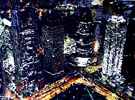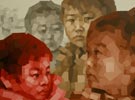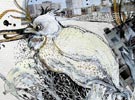Freschini: Sakya animation analyze the paradox between the religious world, the transcendental matter and the materialized reality, how do you personally deal with this comparison, how do these two worlds face each other in your daily life?
Zhang: In the Sakya animated film, I focus on a certain paradox between the spiritual world of Buddhism and the real world. I hope to present this contradiction and isolation between the material and the spiritual. The documentary looks at things entirely from the perspective of the archaeologist, while in the animated film, the encounters of the characters in the labyrinth have a kind of prophetic tone with some game elements. I didn’t think about this much before, but when the animated film reached this point, I suddenly became aware of some contradictory encounters between the real and virtual worlds. I think it’s mainly an issue of comparison, and there are multiple narrative spaces, for instance the comparison between the primary school and the monastery, comparisons between the souvenir market and the monastery, comparisons between rapid urbanization and the natural landscape, etc. Spectacles such as the square in front of Lhasa’s Jokhang Temple are all there. Here, the relationship between secular society and faith becomes quite clear and substantial. This plays out in the opening of the documentary. It is very tense.
The artist must have a persistent, pious devotion to the sacred and must also draw from secular life. Art is like personal cultivation, but this cultivation takes place in the secular world. It is very difficult to separate the two. I try to find a channel between the two, a connection between the secular and the sacred. I have many friends who have converted to Buddhism, and religion becomes an important part of their lives. In 2009 I went with a friend to stay at Guoqing Temple on Mt. Tiantai for ten days, where we chatted with the abbot, watched the scenery, wrote calligraphy, read and painted. A tranquil life is very important. It is difficult to have an opportunity to cultivate the heart and mind. Today’s China is too fast, too crazy. Slowness is a luxury. The meditative state is great. We really need this tranquil way of life.
Freschini: When you first introduced this project to me you said that the artist’s identity has gone while the works presented expansive visual and culture-oriented research... Of course this subject deeply affect our inner self ..
Zhang: The Sakya project is a cross-discipline, cross-media visual cultural research project, one that looks especially at the issue of the secularization of religion from the intersection of Tibetology, archaeology, anthropology, Buddhism, regional politics and other fields. This knowledge surpasses the boundaries of the artist. I have been working together with archaeologists Zhang Jianlin and Xu Tianjin for many years now, and there are many things that require new knowledge backgrounds, such as the management and operations of the documentary and animation teams. This is a test of an artist and his techniques, marked by: 1, cross-discipline and cross media teams; 2, advanced digital teams; and 3, a systematic, intense and highly effective management team that can complete a relatively whole, independent and creative digital art project or artwork.
Freschini: The animation language of Sakya was inclined to the characteristics of both ‘Eastern Mystery’ and ‘Deconstructivism’... What do you mean with this two words?
Zhang: In 1996 I read a book entitled Jung’s Psychology and Tibetan Buddhism, published in China by the Sanlian Bookstore. I’ve always been curious about the relationship between the world of mysticism and things like science and rational psychoanalysis. The concept of the alchemist has always hovered in my memory, and the artist is actually a cultural alchemist, while art is the gold in the artist’s heart. This book is an analytical spiritual comparison of eastern and western mysticism and rational science. “Eastern mysticism” is the mysterious, desolate and vibrant side of the Tibetan natural world that I had always wanted to express in the Sakya animated film. The snowy plateau and the air of Tibetan Buddhist mysticism are enchanting, and this is a tone I set for the film. As for “deconstructionism,” my hope when I made the film is that I could use some virtual elements to deconstruct some of our set views on the plateau and Tibetan religion, so I incorporated a lot of elements such as mandalas, mudra hand positions, stars, human organs, maps and digital cities, which become new visual channels that can inspire our reading of the relationships between classical civilizations and modern civilizations. I’m more concerned with the construction that takes place after deconstruction, which is like the rearrangement of numbers; it is a very concrete task, one which virtually unfolds within contradiction, almost simultaneous with the act of deconstruction. Deconstruction and construction are merely different perspectives, all in hope of opening up a different channel.
Freschini: This work of yours easily appear as visual and mental travel... Where you are not going to guide the viewers to a specific land.. You just give them some suggestions, the path to follow... Each person are free to follow his heart in this adventure... But there is anything you really mean to make them discover about?
Zhang: I hope that my artwork is a journey for the viewer, one beset by uncertainty, full of a sense of surprise and fear like creeping through the dark of night. At the end of the animated film, I sent five characters through a mandala, which is an allegory for multiple dimensions, like the different encounters and conclusions of people within the same time channel in the film Inception. It’s not just about psychology but also about a multiple world of reality, history and the virtual. It requires the artist to ponder and discover. I am also making discoveries. The artist is not the provider of answers but the provider of space for imagination and thinking. If I look at things from the perspective of a Buddhist, then it will present a different spectacle. We need observations and thinking from different dimensions; this is in line with the thinking of each viewer. I don’t wish to provide a standard answer in the film but an open-ended conclusion, so that the thoughts of the artist and the viewers become an extension of this open-ended conclusion.
Freschini: The history of Western art comes out of a Judaeo-Christian legacy and for centuries the relationship between religion and art was very close. It is only in fairly recent times, since the beginning of modernism and the advent of contemporary art, that the two have been considered apart. But, what’s happen here in China? In the west, the connection between art and religion was so strong and important because politic was very closed and involved in this relation as well.
Zhang: In college I studied western oil painting. My formative education actually came from the western Christian traditions of devotional painting. The history of Christianity is a microcosm of western art history. The continuation of devotional painting is a great tradition; during the period of classical civilization, religion and art were fused together. The concepts of patrons and sponsors in China and Europe were quite similar. When Buddhism spread to China during the Han dynasty, the secularization movement of Buddhism had a profound impact on Chinese culture. This was especially the case with Buddhist art, which produced important works of art in different historical periods in China. Buddhist art is a peak in art history. In the time of ancient society, faith and art were fused together. The Medici family’s support of the Sistine Chapel ceiling fresco, China’s Dunhuang Grottoes, Yungangling Grottoes, Longmen Grottoes and Maijishan Grottoes are all cases of art and religion’s involvement in politics. The construction of religious facilities at important ancient Chinese temples and Zen monasteries were mostly supported by the imperial family, and became imperial religious facilities. I think that on this point, the sense of sacredness and universal values were quite comparable among the classical arts of both East and West. In today’s China, religious faith is free and politics and religion are separate. Religion is more on the level of the cultural and spiritual, and the greatest assault against religion now is faith in the material. This is not only the case for the Tibetans; it is even more evident among the Han Chinese. The decline of education, the collapse of humanism, these are the negative effects of China’s social development over the last three decades. We are a speeding train that cannot stop. We are worried because we don’t know where this train will go. Is it safe? Will it derail?
Freschini: Here, politic and religion never have been so deeply linked together each others... As you said there was a connection between Buddhism Art and Imperial family… but lots of this have been damaged because of the time and canceled, removed by human actions, the cultural revolution, … Perhaps there is something invisible inside Chinese people, a spiritual inner still alive and able to rebuilt a sacred path. What is you personal story? How can you see evolving this relation ship between art and religion in your Country?
Zhang: There are some great artworks among the frescoes and carvings of ancient Chinese temples. They were made at the time by artisans. In classical Chinese art history, religion, politics and art were fused together, as you can see with the imperial tombs, temples, Daoist shrines and cliff carvings. These were all contained within everyday life. This thread was an independent system from our ink wash painting and literati painting. In the past, it was classified as folk art, but this classification is problematic. Among ancient Chinese art education, there was so much folk art outside of the mainstream that was really great. For instance, woodcut printing was used quite early on in Buddhist sutras, and the illustrations and texts of these sutras were spread among millions of believers, from the mouth straight to the heart. This knowledge sparked wisdom among the masses. Western Christianity also has a concept of “the spirit becoming flesh.” I think these influences continue to this day, hidden, concealed within our blood.
I agree with what you say about Chinese people having a spiritual tradition concealed inside them, but concern for the current world and for family bonds win out over the passage of spiritual traditions. The question of how to reconstruct our inner world of faith is a massive topic, but my hope for the Sakya project is to construct a dialogue between Tibetan Buddhism, archaeology, anthropology and new media technology. Personal religion and Buddhism are two different things, but we will use artistic methods to focus on society, to intervene in society and to give back to society. Income from the sales of the Sakya catalogue and some related products will be donated to impoverished schools in Tibet. I’ve gotten help from Gade, the Tibetan curator. He is full of passion, friendliness and kindness, and he did a lot to aid the completion of this film. Through such practices we will begin to give back to society, to gain an understanding of the wisdom and enlightenment of the Buddha. The light of Buddha shines on the hearts of all people. This is a cycle and a practice. It is like there is a channel and a connection between art, society and religion. Through this method we can make a difference in a small way.




